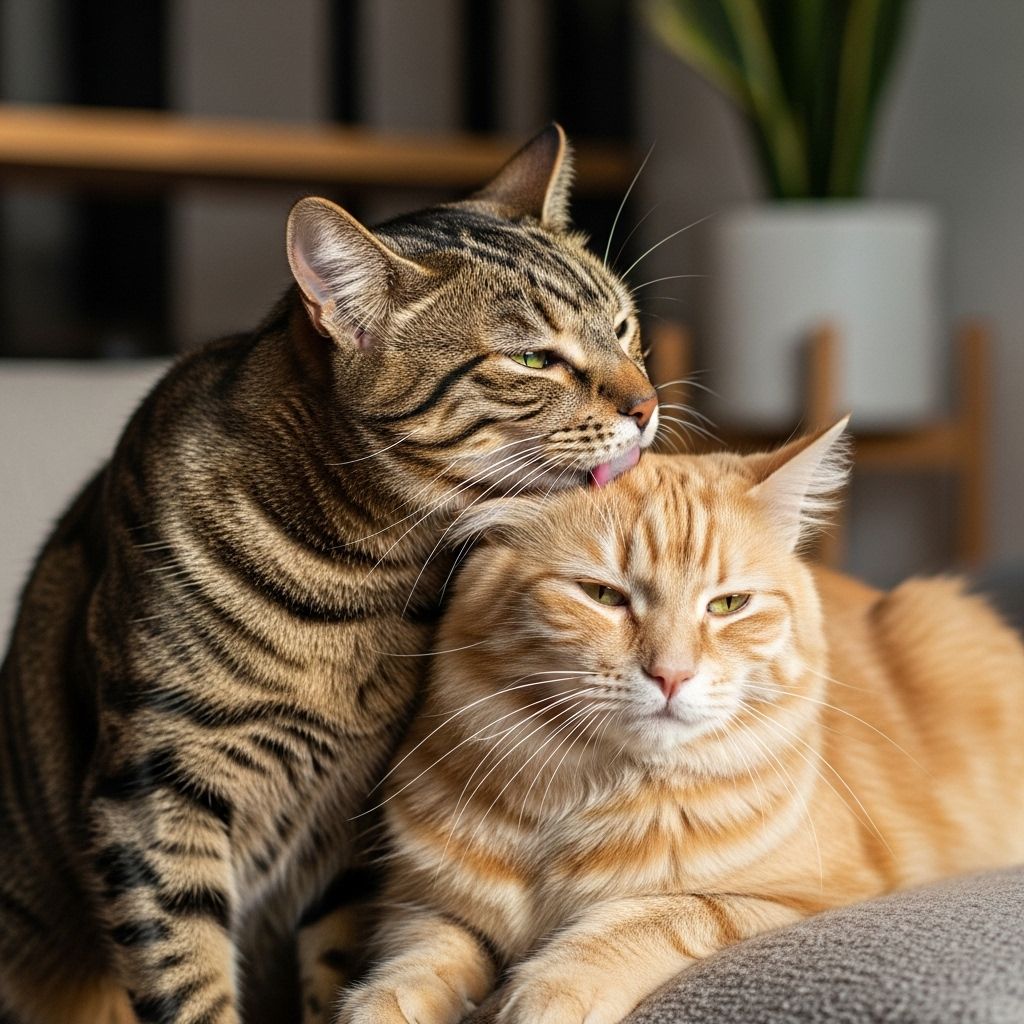Can Two Male Cats Get Along? Facts & Compatibility Guide
Discover the truth about male cat compatibility and bonding success

If you’re considering adding another feline companion to your household and already have a male cat, you might be wondering whether two male cats can coexist peacefully. This common concern among cat owners deserves a thorough examination, as the dynamics between cats can significantly impact the harmony of your home.
The good news is that male cats can absolutely form strong bonds with other male cats. Success depends far less on gender and much more on factors like personality, age, neutering status, and how the introduction process is handled. Understanding these elements will help you create the best possible environment for feline friendship to flourish.
Understanding Male Cat Social Behavior
Contrary to popular belief, male cats are not inherently aggressive or incompatible with other males. The social structure of cats is far more nuanced than simple gender dynamics. Research and observation of feline behavior reveal that cats living in groups—whether feral colonies or multi-cat households—organize themselves based on individual personalities rather than sex.
In wild or feral cat populations, groups typically consist of related females and their offspring. However, this doesn’t mean male cats cannot form social bonds with other males. Unrelated males, male-female pairs, and mixed groups can all coexist successfully when conditions are favorable. The determining factors are typically the individual cat’s temperament, early life experiences, and whether they’ve been properly socialized with other felines.
Male cats that have been neutered show dramatically different social behaviors compared to intact males. Without the influence of testosterone and reproductive hormones, neutered males tend to be less territorial and more accepting of other cats in their space. This hormonal difference is perhaps the single most important factor in determining whether two male cats will successfully bond.
The Role of Neutering in Male Cat Compatibility
Neutering plays a critical role in whether two male cats can live together harmoniously. Intact male cats are driven by powerful hormonal urges that influence their territorial behavior and aggression levels. An unneutered male seeks to mate with as many females as possible within his territory, which creates an inherent conflict when another sexually mature male enters the picture.
Sex-driven aggression can manifest in several ways, including urine spraying to mark territory, physical confrontations, and constant vigilance against perceived threats to their domain. These behaviors make it extremely challenging to introduce two intact males, and the stress can be overwhelming for both cats and their human caregivers.
When male cats are neutered, these hormone-driven behaviors diminish significantly. Neutered males are often described as among the most accepting and laid-back of all cats. They’re less likely to view another male as a reproductive competitor and more likely to accept companionship. For this reason, ensuring both male cats are neutered before attempting an introduction is essential for success.
Beyond reducing aggression and territorial behavior, neutering also prevents unwanted breeding, reduces the risk of certain health issues, and generally creates a calmer household environment. If you’re serious about having two male cats coexist peacefully, neutering both should be considered non-negotiable.
Personality Factors That Influence Compatibility
While neutering addresses hormonal factors, personality plays an equally important role in determining whether two male cats will get along. Cats, like humans, have unique temperaments that shape how they interact with others. Some cats are naturally gregarious and enjoy the company of other felines, while others prefer solitude and may never fully accept another cat in their territory.
A cat’s early life experiences significantly influence their social behavior. Kittens that interact with other cats during their critical socialization period—roughly the first eight weeks of life—typically develop better social skills and are more accepting of feline companions later in life. Conversely, cats that were hand-raised by humans without exposure to other cats may struggle to understand feline social cues and communication.
Age also matters considerably. Younger cats are generally more adaptable and flexible when it comes to accepting new companions. They haven’t yet established deeply ingrained territorial habits and are often eager to play and interact with others. Adult and senior cats, particularly those who have lived alone for extended periods, may be less receptive to change and more set in their solitary ways.
A sociable adult cat with previous positive experiences living with other cats will likely welcome a new companion more readily than a cat that has always been an only pet. However, there are always exceptions—some cats surprise their owners by forming unexpected bonds, while others remain aloof despite having all the “right” characteristics for friendship.
Assessing Your Current Cat’s Readiness
Before bringing a second male cat into your home, carefully evaluate your current cat’s personality and behavior. This assessment will help you gauge the likelihood of success and prepare appropriately for the introduction process.
Observe how your cat reacts to other cats he sees through windows or encounters during veterinary visits. Does he show curiosity and interest, or does he display fear, aggression, or extreme stress? Cats that hiss, growl, or become agitated at the mere sight of another cat may need more careful consideration before adding a second feline to the household.
Consider your cat’s attachment patterns. Is he extremely bonded to you or another family member to the point of being possessive? Overly dependent cats may view a new companion as an unwelcome rival for your attention rather than a potential friend. This doesn’t necessarily mean they can’t eventually adjust, but it suggests the process may require extra patience and management.
Your cat’s history also provides valuable clues. If he lived with other cats previously and those experiences were positive, he’s more likely to accept a new companion. Conversely, if past experiences with other cats were negative or if he’s never lived with another feline, the adjustment period may be longer and more challenging.
Finally, ensure your current cat is healthy and fully vaccinated before introducing a new cat. Stress can compromise the immune system, and the introduction process itself is inherently stressful. Having both cats in optimal health reduces the risk of illness spreading between them.
The Introduction Process: Setting Up for Success
Even when two male cats have all the right characteristics for compatibility, the introduction process itself can make or break their relationship. Rushing introductions is one of the most common mistakes cat owners make, and it can create lasting negative associations that are difficult to overcome.
The key to successful introductions is patience and gradual exposure. Begin by keeping the new cat completely separated from your resident cat in a dedicated room with all necessary resources—food, water, litter box, toys, and comfortable resting spots. This allows the new cat to decompress from the stress of relocation while letting your resident cat become aware of the newcomer’s presence through scent.
Scent is incredibly important in feline communication. Before the cats meet face-to-face, exchange bedding or toys between them so they can investigate each other’s scent in a non-threatening context. You can also rub a towel on one cat and place it near the other’s feeding area, creating positive associations between the new scent and pleasant experiences like eating.
After several days of scent exchange, allow the cats to see each other through a barrier, such as a baby gate or a slightly cracked door. Watch their body language carefully. Signs of interest like approaching the barrier, relaxed body posture, and calm vocalizations are positive. Hissing, growling, flattened ears, or attempts to flee indicate the cats need more time before progressing.
When the cats show consistent calm behavior during visual contact through barriers, you can attempt supervised face-to-face meetings in a neutral space. Keep these initial interactions brief and positive, and always provide escape routes so neither cat feels trapped. Have treats or favorite toys on hand to create positive associations with each other’s presence.
Managing Territory and Resources
Territorial concerns are at the heart of many feline conflicts, making resource management crucial for maintaining peace between two male cats. Even after a successful introduction, ongoing attention to how resources are distributed can prevent conflicts from developing.
Provide multiple feeding stations in different locations rather than having both cats eat side-by-side. This reduces competition and allows each cat to eat at their own pace without feeling threatened. Similarly, ensure you have enough litter boxes—the general rule is one box per cat plus one extra, distributed throughout your home.
Vertical space is incredibly valuable for cats. Installing cat trees, shelves, or window perches at different heights allows cats to claim territory in three dimensions rather than competing for the same floor space. Higher positions often confer social status in feline hierarchies, so providing multiple high spots can reduce tension.
Each cat should have their own set of toys, scratching posts, and comfortable resting areas. While some cats may eventually choose to share resources or even sleep together, having separate options ensures neither cat feels deprived or needs to compete for access to essential items.
Your attention is also a resource that cats may compete for. Make sure to spend individual quality time with each cat, engaging in play sessions and providing affection according to each cat’s preferences. This prevents jealousy and reinforces that the new cat’s presence doesn’t diminish the resident cat’s relationship with you.
Signs of Successful Bonding
As two male cats adjust to living together, certain behaviors indicate that their relationship is developing positively. Understanding these signs helps you gauge whether the introduction is proceeding well or if intervention is needed.
Mutual grooming, known as allogrooming, is one of the strongest indicators of a positive relationship. When cats groom each other, particularly around the head and neck, they’re engaging in affiliative behavior that strengthens social bonds. This behavior typically emerges only after cats have established trust and acceptance.
Playing together is another excellent sign. While play styles vary, cats that chase each other, wrestle without serious aggression, or engage in coordinated hunting games are demonstrating social comfort and enjoyment in each other’s company. Playful interactions should look loose and relaxed, with frequent role reversals where each cat takes turns being the chaser and the chased.
Sleeping near each other, even if not touching, shows that both cats feel safe and secure in the other’s presence. As their relationship deepens, they may progress to sleeping in contact with each other, which represents a high level of trust and bonding. Some cats develop such close relationships that they become distressed when separated.
Synchronized behaviors like eating at the same time, using the litter box in sequence, or coordinating their activity periods also indicate successful integration. When cats align their routines, it suggests they’ve accepted each other as part of the same social unit.
Troubleshooting Common Challenges
Despite your best efforts, complications can arise when introducing two male cats or maintaining their relationship over time. Knowing how to address common challenges can prevent minor issues from escalating into serious problems.
If the cats show persistent aggression beyond normal adjustment hissing and posturing, separate them and slow down the introduction process. Return to earlier stages like scent swapping and visual contact through barriers. Some cat pairs simply need more time than others to accept each other.
Redirected aggression can occur when one cat becomes aroused by an external stimulus—like seeing an outdoor cat through a window—and directs that aggression toward the other resident cat. If this happens, separate the cats immediately and give them time to calm down. Address the source of arousal if possible, such as blocking the view of outdoor cats that trigger stress.
Resource guarding may develop if one cat attempts to monopolize food, litter boxes, or access to favorite people. Increase the number and distribution of resources, and consider feeding the cats in separate rooms if food competition is an issue. Never punish either cat, as this creates negative associations and increases stress.
Some cats may never become best friends but can still coexist peacefully. Acceptance doesn’t always mean affection. If your cats ignore each other, maintain separate territories within your home, and don’t show signs of stress or aggression, they may have reached a stable détente that works for everyone.
The Reality of Male Cat Relationships
Real-world experiences with male cats often confirm that successful bonding is entirely possible. Many cat owners report that their male cats became inseparable companions, engaging in mutual grooming, synchronized sleeping, and coordinated play sessions. Some pairs bond so strongly that they show distress when separated, even briefly.
Age gaps don’t necessarily prevent bonding. Older male cats can successfully bond with kittens, often adopting a mentor-like role. The energy and playfulness of a younger cat can even revitalize a senior cat, providing mental stimulation and physical activity that contributes to better health and wellbeing.
However, it’s equally important to acknowledge that not all male cat pairings result in close friendships. Some cats remain cordial but distant housemates, while others require permanent separation due to incompatibility. These outcomes don’t reflect failure on anyone’s part—they simply represent the reality of individual feline personalities.
The key is approaching the situation with realistic expectations, patience, and a willingness to adapt based on how each cat responds. Success may look different than you imagined, but creating a peaceful multi-cat household is achievable for most owners willing to invest the time and effort required.
Long-Term Relationship Maintenance
Once two male cats have successfully bonded or reached a stable coexistence, ongoing attention helps maintain their relationship over time. Life changes, environmental stressors, and health issues can all impact feline relationships, requiring periodic reassessment and adjustment.
Major household changes like moving, renovations, or the addition of new family members can disrupt established cat relationships. During these transitions, provide extra resources, maintain routine as much as possible, and give both cats plenty of reassurance and attention.
Health problems can alter cat behavior and relationships. A cat experiencing pain or illness may become irritable and less tolerant of normal social interactions. Regular veterinary care ensures both cats remain healthy and that any medical issues are addressed promptly before they impact the household dynamic.
Environmental enrichment benefits all cats but is particularly important in multi-cat households. Interactive toys, puzzle feeders, window perches, and regular play sessions provide outlets for energy and hunting instincts, reducing the likelihood of conflicts arising from boredom or frustration.
As cats age, their needs and behaviors change. A pair that played vigorously together as young adults may prefer quieter companionship in their senior years. Remain attentive to shifts in their relationship and adjust your management strategies accordingly.
Frequently Asked Questions
Q: Does gender really matter when choosing a second cat?
A: Research suggests that gender is less important than factors like personality, age, neutering status, and early socialization experiences. Two neutered male cats can form just as strong a bond as any other gender combination. The individual temperament of each cat matters far more than their sex.
Q: How long does it typically take for two male cats to accept each other?
A: The timeline varies dramatically between individual cats. Some pairs bond within days or weeks, while others require several months to reach comfortable coexistence. Patience is essential, and rushing the process often backfires by creating negative associations that are difficult to overcome.
Q: Can intact male cats ever live together peacefully?
A: While not impossible, intact males face significant hormonal challenges that make peaceful coexistence difficult. Testosterone drives territorial aggression and competition for mating opportunities, creating constant tension. Neutering both males dramatically improves the chances of successful bonding.
Q: What if my resident male cat has always lived alone?
A: Cats that have lived alone for extended periods may be less flexible about accepting a new companion, but success is still possible. These situations typically require more gradual introductions, extra patience, and realistic expectations. Some solitary cats eventually warm up to a carefully chosen companion, while others may prefer to remain alone.
Q: Should I get two male kittens or introduce an adult to my adult male cat?
A: Both approaches can work. Two kittens from the same litter often bond easily and provide each other with play companionship. Introducing a younger cat to an established adult can also work well, as the age difference may reduce competition. Consider your resident cat’s personality—some adults appreciate a kitten’s playfulness, while others find it overwhelming.
Q: What are the warning signs that two male cats will never get along?
A: Persistent, escalating aggression that doesn’t improve with time and proper introduction techniques may indicate fundamental incompatibility. If either cat shows chronic stress symptoms like hiding constantly, refusing to eat, or developing litter box problems despite your best efforts, the pairing may not be viable. Consult with a veterinarian or animal behaviorist before concluding that separation is necessary.
Read full bio of medha deb












